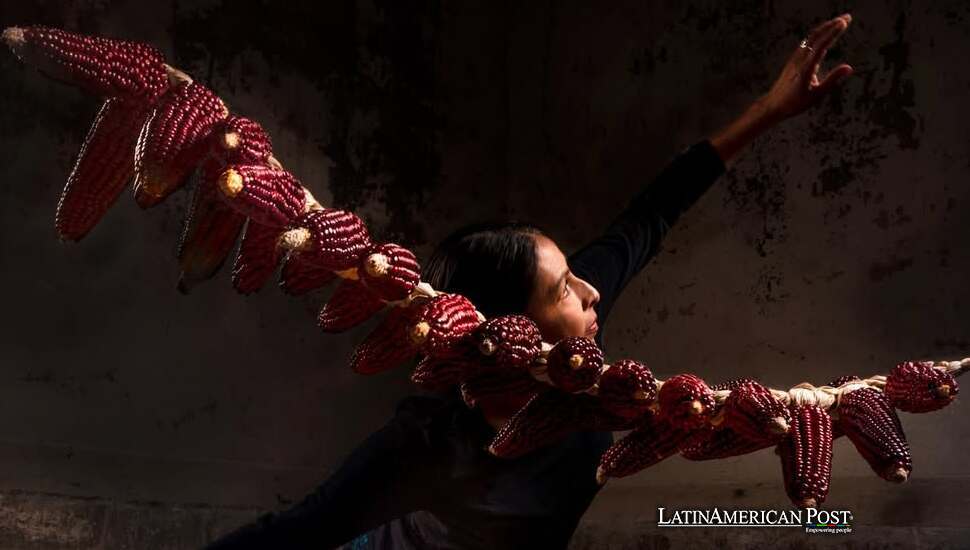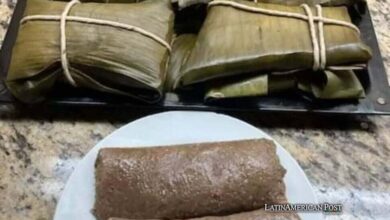Mexico’s Sun Embracing Maize Sparks Beautiful Artistic Vision

Under the warm rays rising over Hacienda Santa Bárbara in Tlexaca, Mexico, photographer Malena Díaz greets a new day. She stands amid ancient architecture and fields of growing corn, committed to sharing her ancestors’ legacy through images and cultural preservation.
A Morning in Hacienda Santa Bárbara
In Tlexaca, early sunlight lights up Hacienda Santa Bárbara, showing a view with stone walls, tall trees, and neat rows of corn. At each dawn, the old hacienda wakes; its fields change to green and then gold under the rising day. On mornings like these, photographer Malena Díaz feels especially connected to her roots. She gazes at the sprawling acreage, breathing in the crisp, earthy air, and mentally frames the shots she hopes to capture.
Díaz is no stranger to the rigors of work that come with tending farmland. Part of her daily ritual involves walking the perimeter of the hacienda to ensure the maize is healthy and thriving. But she also lingers camera in hand, observing how light beams pierce through the clouds. These subtle shifts in color and shadow feed her artistic process. Even though she has exhibited internationally—her latest show, La Trenza, appeared in Madrid—her soul belongs to the rural Mexico she captures through her lens.
“Seeing how the sun slowly embraces these fields of maize reminds me I have few outstanding debts with life,” she often remarks. By “debts,” Díaz refers to her quest to honor the legacy her ancestors entrusted to her: the dedication to cultivating maize and caring for the land that shaped her heritage. The camera and the fields are integral to her identity, each representing vital threads in the tapestry of her life’s work.
Yet beyond simply chronicling the land, she pours herself into preserving the cultural rituals tied to the milpa. This traditional, polyculture farming system includes beans, squash, chiles, and other crops alongside corn. Long hours of patient observation in the field enable her to capture nuances that many might miss: how a breeze rustles the leaves, the way morning dew clings to newly formed tassels, or the protective dance of a farmer who gently checks the corn’s progress.
Sowing Photographic Seeds of Heritage
Malena Díaz started in photojournalism. She recorded social and political issues across Mexico. She felt a strong call to her family’s past. As she looked deeper into her past, she saw that the story she wanted to share was of family and identity next to the nature that supports her community. Eventually, her lens settled on the maize fields surrounding Hacienda Santa Bárbara—a focus she has maintained with unwavering devotion ever since.
Her exhibit La Trenza, showcased at the Cultural Institute of Mexico in Spain, interweaves personal photographs with narrative descriptions of people who cultivate maize and the generations that depend on this staple crop. She highlights the cyclical interplay between the land and the families who raise and harvest it. Each photograph becomes a statement of connection: children with husks in their hands, elders teaching younger generations how to prepare the soil, or women laughing as they grind kernels on a metate (a traditional Mesoamerican mortar) to make dough for tortillas.
“The maize is alive,” Díaz says, reflecting on its broader significance. “It connects people because they exchange seeds, share harvested crops, and build lives around sowing, tending, and reaping. It’s not a fad but a way of life.” For her, each frame is a record of everyday heroes: farmers, neighbors, and extended families who show her that maize is more than just a food source—it is a unifying symbol of cultural continuity.
Her ongoing experiences reflect that sense of awe, which she describes simply as “Nature surprises me. I like to observe it. I owe my chance to document corn to this appreciation for the land’s rhythms and the people working in harmony with it.” While many might see a daily routine in these fields, Díaz recognizes an ongoing dance of sun and soil, humming with generations of knowledge and care.
Preserving Mexico’s Cultural Identity Through Each Photograph
Hacienda Santa Bárbara has become a living canvas for Malena Díaz’s photographic experiments. Built centuries ago, parts of the hacienda maintain their original structure, including a 17th-century chapel. From the hacienda’s rooftop, you can glimpse an expanse of maize fields, a realm in which nature weaves centuries-old magic. La Malinche volcano stands in the distance, its gentle slopes silhouetted against the sky. Below, clusters of dried husks and rows of thick green stalks frame the fields that have nurtured countless families over generations.
Díaz set aside a portion of the hacienda as her gallery. Alongside images depicting the sowing, harvesting, and culinary uses of maize, she also displays artistic scenes drawn from her imagination. “Sometimes I explore more artistic setups because if I were a painter, I would portray my dreams of the countryside,” she explains. “It ties back to the total connection with the milpa and the creatures living there.” For her, capturing the synergy of snakes, rabbits, endangered chameleons, bees, bats, the starlit sky, and the radiant moon above the fields is tantamount to documenting pure alchemy—a transformation reminiscent of the painter Remedios Varo’s mystical compositions.
Visitors can learn firsthand about the maize cycle in her gallery’s workshop space. Díaz encourages them to experience the process: shelling kernels with an olotera, a tool used to detach dry corn from the cob; nixtamalizing the kernels by boiling them with water and lime; and finally grinding them into masa (dough) on a metate for fresh tortillas. “You grind your corn, make your tortillas, then taste your work,” she says, describing a personal moment. Through these workshops, she hopes old methods live on so the skills of working the land and making traditional foods stay within the culture.
Her drive goes past the hacienda. She grieves that very few rich investors consider replanting or protecting these lands. Yet Díaz stays hopeful; she believes carbon credit trading and concern for nature can push more careful methods. “Our only way forward is to respect nature,” she insists. To her, spending on good soil and long-lasting farming brings the greatest profit, not only in money but also for our heritage.
Harvesting Inspiration and Looking Ahead
Malena Díaz’s dedication to maize doesn’t end with the borders of her hacienda. Her work has appeared in over 300 exhibitions in Mexico and abroad, linking cultures and letting city viewers experience the spirit of country life. She often calls this larger initiative “La Ruta del Maíz,” or “The Path of Corn,” a concept born in 2022 that envisions traveling showcases and tasting events held in different venues. For instance, by partnering with Hoteles Misión in Mexico, she organizes gastronomic festivals and pop-up galleries. Patrons don’t merely view photographs—they immerse themselves in the flavors and aromas of tortillas made from heritage corn, sip on traditional drinks, and converse with local farmers about the everyday challenges and triumphs in the fields.
Another branch of this project finds a permanent home at the Museo de la Isla in Cozumel. A gallery room named “Los Hijos del Maíz” will open. It will show images that mix personal stories with wider social settings and honor family ties built around growing maize. This endeavor, scheduled to launch in May, is a testament to Díaz’s mission to sustain these dialogues for future generations—an invitation for visitors to understand that the story of Mexico’s farmland is, in many ways, the story of Mexico itself.
She also has plans for an exhibit at the Hotel Camino Real in Puebla, where curated photographs showcasing the full cycle of corn growing and processing will be displayed. Each stage underscores the complex synergy between land, community, and culture, from sowing seeds at sunrise to sampling tortillas cooked on a traditional comal. For Díaz, each exhibit is not just art but a teaching tool that shows returning to old ways may help modern society reach a healthier, more balanced state.
Díaz uses words and pictures to show nature’s beauty. She names many creatures – snakes, rabbits, insects that pollinate, and field birds – that work to keep harvests balanced. Her photographs aren’t always straightforward—some are spontaneous shots taken in the hush of dawn, while others are lightly staged to depict something akin to a dreamlike painting. Yet each one resonates with the same underlying message: we must remember how intricately our lives are tied to the land and the cultural practices that arose from it.
Whether gathered from the quiet happiness of a morning in the fields or the busy energy of a traveling art exhibit, Díaz’s message remains consistent. “The progress of today’s thinking often lies in creating more things,” she points out. “They forget the real future is caring for the land that nourishes us.” Her optimism wavers only when she contemplates the rate at which highways, factories, or urban sprawl might replace farmlands. But she insists that investing in nature is humankind’s best path forward, citing carbon credits and sustainable farmland strategies as testaments to a budding shift in global consciousness.
Caminar por la muestra de Díaz es seguir una historia que va de la semilla a la tortilla, del amanecer al atardecer, del pasado al futuro. Su amor por el maíz es más que un interés personal; es un propósito que invita a los visitantes a replantear el progreso. Su mirada muestra que la verdadera riqueza reside en siglos de saber compartido, en el lazo entre la gente y la tierra, en las tradiciones que nos unen.
Al fin entrar en Hacienda Santa Bárbara al amanecer muestra más que una vista hermosa de postal. It unveils a vow to keep the spirit of maize alive in every aspect of daily life. Díaz’s farmland vantage point shows how the old chapel coexists beside new seedlings pushing through rich soil and how the thunderous hush of morning can bring forth the laughter of children learning to nixtamalize corn for the first time. It exemplifies how a single day in Mexico’s countryside can blend the ancient with the modern, culminating in the promise of a culture that grows and evolves like maize—rooted firmly in tradition yet always stretching toward the light.
Through her photography, Malena Díaz ensures that each sunrise in Tlexaca, each row of flourishing corn, and every hidden corner of her ancestral land is carefully documented and shared. Her images remind us that while the busyness of modern life might close our eyes to our heritage, a single glimpse into these fields—teeming with possibility—can stir a yearning to return home, reexamine our past, and craft a healthier, more harmonious future.
Also Read: The 50 Best Spanish-Language Love Songs of All Time
And so, as dawn breaks once again over Hacienda Santa Bárbara, Díaz stands with her camera ready—a sentinel of Mexico’s deep-rooted legacy, capturing the very essence of what it means to treasure the earth and the seeds that sustain us all.





